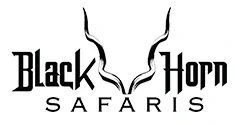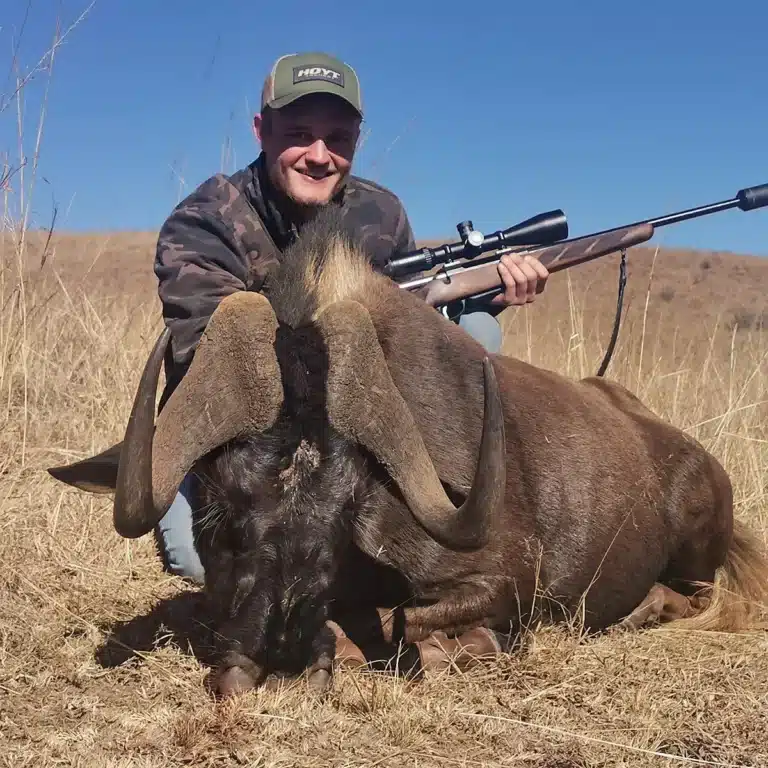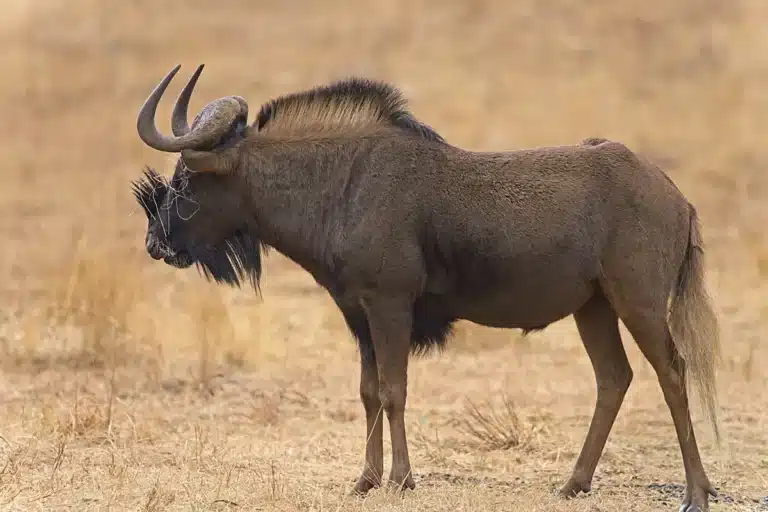
Black wildebeest hunting is a unique and challenging Safari experience that draws hunters from across the globe. This activity typically takes place in the vast open plains of southern Africa, where the Black wildebeest, also known as the White-tailed Wildebeest, is native. Wildebeest are renowned for its unpredictable behavior and swift, agile movements, making it a challenging but rewarding quarry for seasoned hunters. In hunting these distinctive animals, hunters not only immerse themselves in a thrilling African hunting safari, but also in the rich biodiversity and stunning landscapes of the African grassveld. Just a few years ago Black Wildebeest were on the brink of extinction. The populations have been resuscitated by local land owners and through sustainable hunting practices.
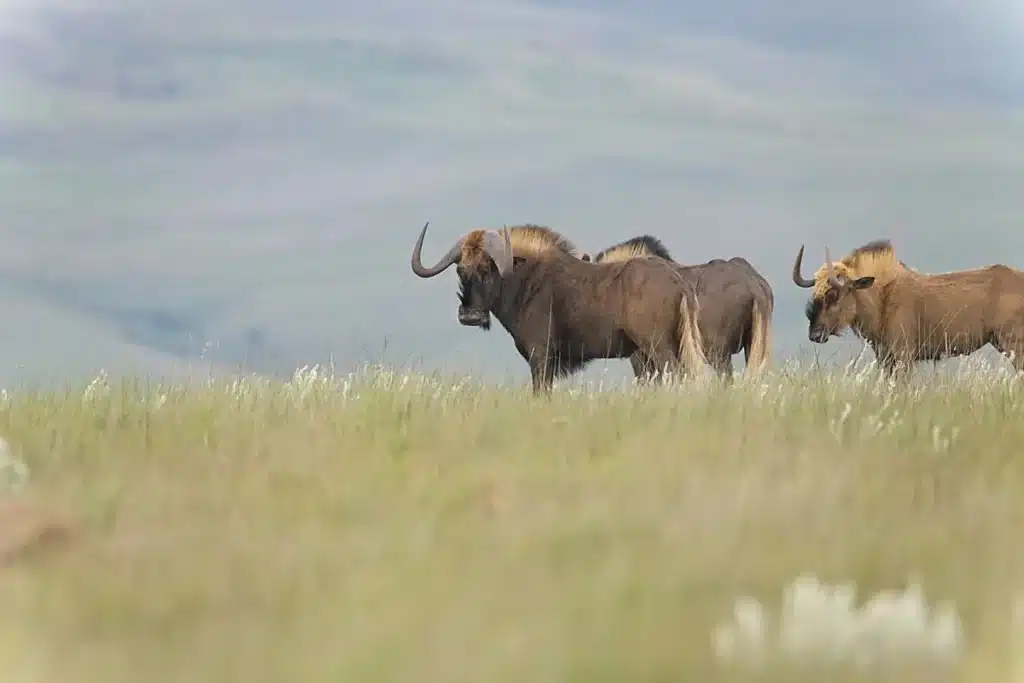
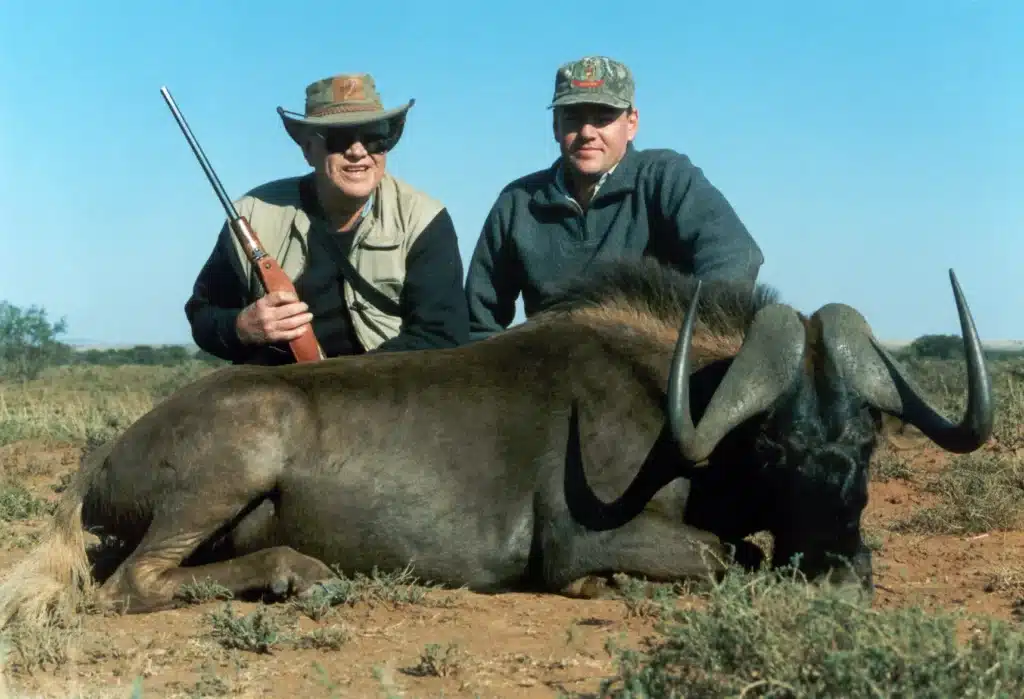
Description – Appearance and Characteristics
The Black wildebeest is unique and distinctly different from the other Wildebeest species found on the African continent. The Black Wildebeest, or White-tailed Gnu (Connochaetes gnou), is an interesting animal endemic to the southern regions of Africa. It is easily distinguishable from its close relative, the Blue Wildebeest, by its dark brown to black coat, long white tail, and the unique forward-curving horns. Both bulls and cows carry horns. Adult Black Wildebeest bulls typically stand about 43 inches at the shoulder and weigh around 300 pounds. The species has a robust, front-heavy build with a noticeably large hump over the shoulders, a long, horse-like mane, and a thick, white beard-like tuft of hair under its chin. Wildebeest eyes and nose have a noticeable black coloration, contrasting with the white tail and mane and beard. They are Notorious for their unpredictable behavior, they are known to be quite formidable when threatened, making it a challenging and sought after quarry for trophy hunters. Black Wildebeest are part of the plains game group of antelope and often graze along side Blesbok – see plains game hunting.
Best Areas for Hunting Black Wildebeest in South Africa
For hunters seeking the thrill of a Black Wildebeest, the southern regions of Africa offer the best hunting areas. In South Africa, the Free State and Eastern Cape, Mpumalanga and North West provinces are particularly renowned for their large populations of Black Wildebeest. These areas, characterized by expansive grasslands and open bushveld, provide ideal habitats for Black Wildebeest. Similarly, Namibia’s vast open areas are also home to numerous Black Wildebeest. The private game reserves in these provinces, which focus on sustainable harvesting, offer hunting quotas. Through responsible and ethical hunting, populations can be maintained and the delicate balance of Black Wildebeest and these ecosystems can preserve the species for future generations.
Trophy Size of Black Wildebeest
When it comes to Black Wildebeest, the size of the animal’s horns is number one factor in determining the quality of the animal. On average, the animals taken while hunting mature Black Wildebeest measure between 21 and 23 inches using the Rowland Ward measurement method. Outstanding Wildebeest trophies can exceed 25 inches, which is considered exceptional for this species. Trophy hunting is one of the aspects of Wildebeest hunts that attracts hunters from around the world for a hunt in South Africa. Rowland ward minimum for entry is 22 7/8 inches and Safari Club International a score of 72.
World Record
The world record African Black Wildebeest stands as a remarkable testament to the extraordinary growth potential of this species under the right conditions. Holding the RW title for the largest recorded size for this species is an individual with perfect genetics that measured an impressive 30 & 7/8 inches.
Rifles and calibers for a Black Wildebeest Hunt
The choice of rifle Hunting caliber for Black Wildebeest is crucial, they are considered a tough animal and the probability of longer shooting distances. We typically recommend a medium to high caliber rifle for Wildebeest. Calibers such as .270 Winchester,7mm Remington Magnum .30-06 Springfield, .308 Winchester, and 300 Magnum is an even better choice for their effective balance of hitting power and precision when hunting Wildebeest. A premium grade soft point or monolithic bullet of appropriate weight for the chosen caliber is recommended to ensure adequate penetration and a quick, humane kill on a dominant male Black Wildebeest trophy. It is essential to be proficient with your chosen firearm before embarking on a hunting trip, ensuring you can handle the recoil and place an accurate shot under various conditions at longer range.
Optics for a South African Wildebeest Safari
Selecting the right rifle scope for Black Wildebeest can greatly increase the chances of a successful hunt. Given the wide open terrain and typical longer shooting distances on the open African grasslands, a variable power scope with a minimum range of 3-9x or 4-12x are a great choice, providing enough magnification for longer range shots.
The typical ranges that these animals are shot vary from around 180 to 300 meters. In extreme cases with very skittish animals you might be required to shoot out to 450 meters.
A reticle with holdover points can be a big advantage for compensating for bullet drop at longer distances.
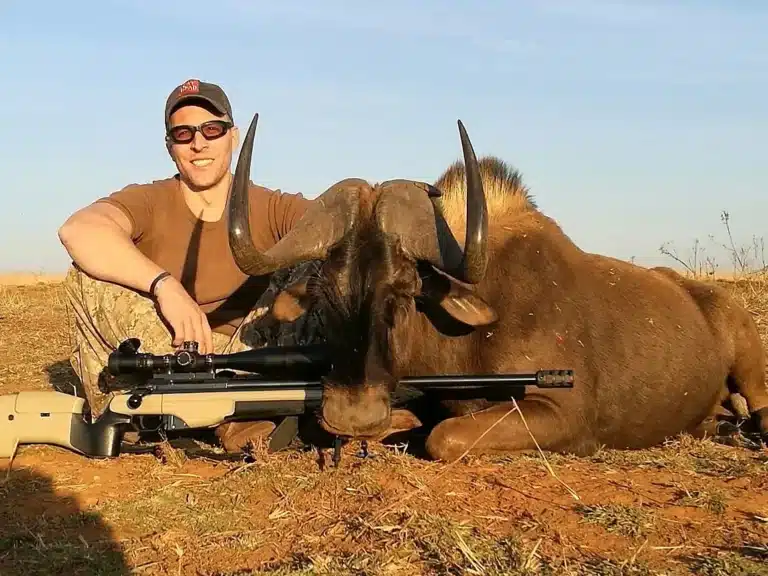
Shot Placement on White-Tailed Gnu
Effective shot placement is crucial in ensuring a swift and humane kill when hunting trophy Black Wildebeest. As with many larger African plains game, the most effective shots are typically aimed at the vital organs located in the chest cavity. This means aiming for the heart and lung area on or just behind the shoulder. When the animal is broadside, this can be achieved by placing the shot in the bottom third of the animal directly above the front shoulder. If the animal is facing towards or away from the hunter, it is often recommended to wait for a better shot angle to avoid wounding the animal. The quartering away shot is also effective, remember to aim for the bullet to exit on the opposite front shoulder. Black Wildebeest are normally easy to locate and tend to rest during the hottest part of the day, they are best pursued during the early morning or late afternoon while the herd is grazing.
Bow Hunting Black Wildebeest
Bow hunting Black Wildebeest presents a unique set of challenges and rewards, as they are usually found in open areas at long ranges. Stalking to within an ethical shooting distance is often not possible, especially when the bulls are found in the large breeding herds. The most successful method of hunting Wildebeest is from a well constructed pit blind or elevated blind over water or feed. Be sure to wait for the animals to settle down and present a good broadside shot. Once the Wildebeest bull is standing still and offering an unobstructed shot to the vitals, the shot should be taken without delay. Wildebeest often jostle each other around and do not stand still for long.
Bow hunting Equipment for Black Wildebeest
A Bow Hunt for Wildebeest requires a specific set of equipment designed to ensure flat trajectory, good penetration and a quick ethical kill. A top quality compound bow or a crossbow is ideal. The recommended draw weight is 60-70 lbs, ensuring enough power to penetrate the animal’s tough hide and reach the vital organs as well as a flat fast trajectory. Top quality, razor-sharp broad heads and arrows weighing around 450 gr are essential for clean and effective shots.
Crossbow for hunting Black Wildebeest
Hunting Wildebeest with a top quality crossbow has some real advantages. A crossbow is accurate out to much longer ranges than a compound or traditional bow. Crossbows that shoot their bolts at a speed in excess of 400 ft/sec can easily reach distances of 100 meters and still carry enough energy to penetrate the vitals for clean efficient kills.
Crossbows are great for women hunters and children and require little practice to place an accurate shot on game animals.
Hunting Packages That Include a Black Wildebeest
The price or trophy fee for Black Wildebeest is $ 1 450.
Hunting packages including fees for a Black Wildebeest and seven days hunting will cost $ 3 900. This package includes accommodation and meals, drinks, the services of a professional guide and his team of trackers and skinners as well as transportation to and from Johannesburg International airport. Packages are available to include Wildebeest and a number of other game species.
FAQ’s – Frequently Asked Questions
What does it cost to hunt a Wildebeest?
The price for Black Wildebeest hunting is $1 450. Daily rates start at $ 350 per day for a 2 on 1 hunt and will cost $ 450 a day if you will hunting on your own with a guide.
What does a Wildebeest Package hunt cost?
A game package including 1 X Wildebeest, 1 X Blesbuck and 1 X Springbuck and 7 days hunting costs $ 5 200.
This package includes accommodation and meals, drinks, the services of a professional guide and his team of trackers and skinners as well as transportation to and from Johannesburg International airport.
How to hunt Wildebeest?
Wildebeest are herd animals, they are often found in breeding groups with up to 60 Wildebeest cows. They inhabit the open grasslands of South Africa and are usually quite weary of being approached. Because of these factors shooting distances are at slightly longer ranges of between 200 and 350 yards. You will need an accurate rifle with a flat trajectory that is capable of precision shooting at these distances. Shots should be placed on or just behind the shoulder a third of the way up from the animal’s chest. A shot through the vitals (heart and lungs) will produce a fast ethical death.
Because these animals are often found in large herds and the cows also carry horns it is easy to mistakenly shoot the wrong sex animal. Be sure that you target only the big bulls by listening to your Professional Hunting guide.
What is the best shot on a Wildebeest?
Shots should be placed on or just behind the shoulder a third of the way up from the animal’s chest. A shot through the vitals (heart and lungs) will produce a fast ethical death.
What is considered a Big Wildebeest?
On average, the animals taken during Wildebeest hunting measure between 20 and 22 inches using the Rowland Ward measurement method. Outstanding horns can exceed 25 inches, which is considered exceptional for this species.
Rowland ward minimum for entry into the record book is 22 7/8 inches.
Safari Club International requires a minimum score of 72 for inclusion in the record book.
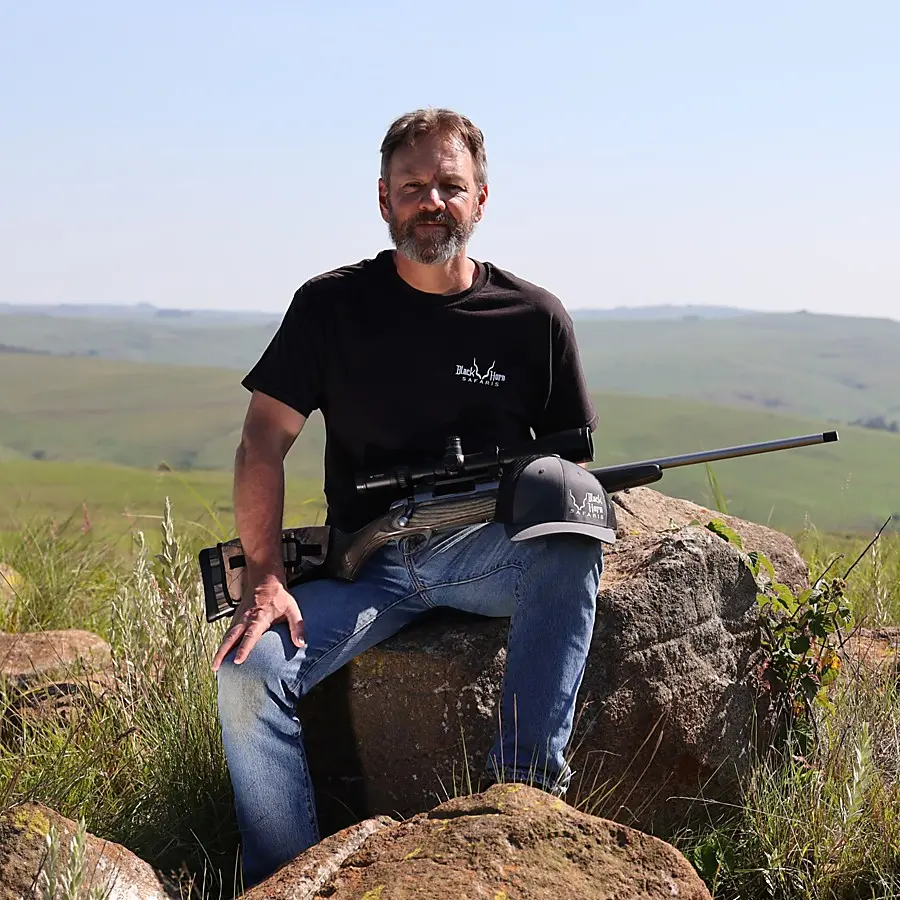
Adrian Anderson first obtained his Professional Hunters license in 1991. He is a Big Five and Dangerous Game licensed Professional Hunter and Hunting Outfitter. He has a tremendous love for wildlife and the African bush and enjoys sharing his knowledge with the hunting clients that he guides. Guiding hunters in Africa’s wild places is a passion and seeing them succeed with their goals brings satisfaction. With knowledge of the Safari industry built up over 32 years he is well qualified to give guidance to his hunting clients.
